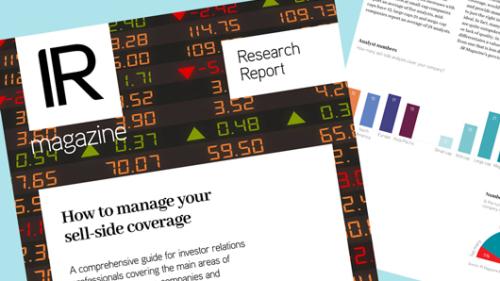Is de-listing inevitable with equity research being hit hard by the crisis? What can companies do to fill the gap in coverage?
p>In a matter of months the entire landscape on Wall Street has changed dramatically. With the demise of Lehman Brothers and the acquisitions of Bear Stearns and Merrill Lynch, remaining firms, including Citi, are struggling to survive. According to recent research, de-listing is inevitable for half of all companies that lose all sell-side coverage, so it’s critical for IR professionals to understand the evolving sell-side environment.
The sell-side model has been changing over the past few years, driven in part by the global research settlement in 2003. Sell-side analysts are no longer compensated at extraordinary levels as the connection between sell-side research and investment banking has greatly diminished. What’s more, the economic downturn has led to consolidation and further job cuts, and sell-side research is no longer dominated by major banks as more and more independent firms are emerging.
This has created a fragmented industry with hundreds of independent research firms. Factor in the buy side’s declining reliance on sell-side research for investment decisions and things look grim. More than 150,000 financial sector jobs have been eliminated globally since mid-2007, and further cuts are likely. It’s estimated that there are 40 percent fewer publishing senior analysts now than there were at the beginning of 2008.
As a result, there are fewer analysts covering fewer companies. Smaller-cap companies – those with market capitalizations less than $1 bn, of which two thirds have lost at least one sell-side analyst – and those trading under $10 a share have been hit the hardest. According to Thomson Reuters’ global review of stocks, between 2007 and Q1 2009, 13 percent of companies lost coverage from at least one sell-side analyst. Overall, 25 percent of companies are now down to just a single sell-side analyst covering their stock.
Limited opportunity
Which companies were most affected? The US, Japan, the UK, Canada and China had the greatest proportion of companies that were dropped by one or more analysts, while stocks in the consumer discretionary sector were affected the most.
With less sell-side coverage, there may be fewer conferences to attend and, as a result, fewer opportunities to speak with the buy side. IR professionals need to work harder to tell their company’s story and may also need to work to obtain new coverage. In addition, the resulting drop in coverage may reduce liquidity and thereby make it harder for buy-side investors to build positions.
With everything that has happened, what is the value of the sell side? Despite the industry’s contraction, consensus estimates are still the benchmark by which companies are measured. Analysts can still move markets with rating upgrades and downgrades.
Facilitating meetings between companies and the buy side and conducting non-deal roadshows are further areas where the sell side continues to play an important role.
Arzu Cevik is a director of strategic research at Thomson Reuters.
Strategies when coverage drops
1. Do it yourself. Don’t wait – talk to the buy side directly. It’s important to discuss the loss of coverage, understand the rationale, prepare comments to refute any controversial points and relay the company’s story to investors who don’t own the stock.
2. Strategize and meet with non-covering sell-side firms. Ask them about their approach to new coverage. Is there a market-cap requirement? Are unfavorable sectors no longer being covered?
3. Review your peer group. Are there sell-side analysts following your peers who don’t follow your company? There might be opportunities for coverage.
4. Maintain contact with analysts who have left the firm. There may be opportunities for new coverage if the analyst is hired at another sell-side firm.
5. Consider paying for research. A number of independent research firms offer this service. Their ratings tend mainly to be buy-oriented.










